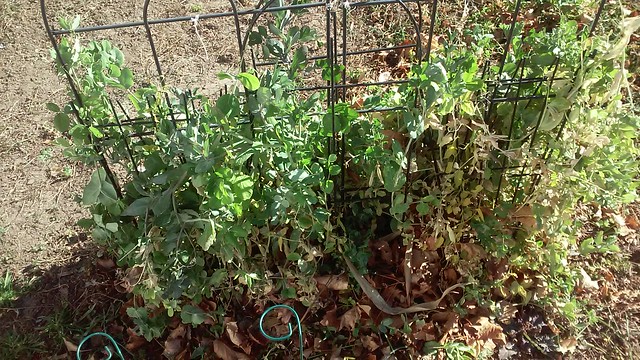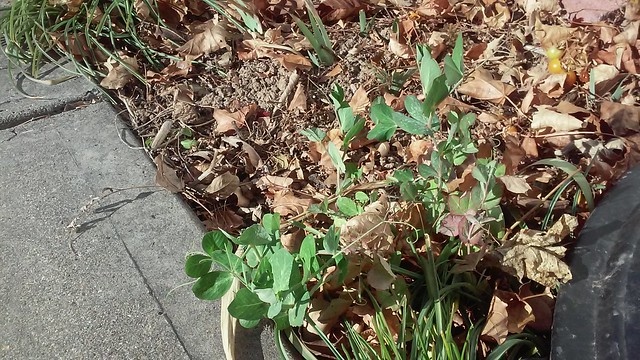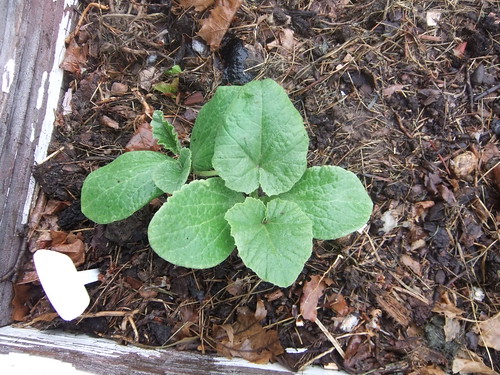|
|
Post by Joseph Lofthouse on Jun 19, 2013 23:25:56 GMT -5
Peas are one of the most popular crops that I grow. It would be really clever to be able to take peas to market a week or two earlier in the season. It seems to me that if I could find a great overwintering shelling pea that flowered early then I might be able to bring shelling peas to market earlier and fetch higher prices. I am using two strategies to try to achieve this goal. First is selection from among my current landrace. Second is to cross a pea that has survived 4 winters in my fields as young plants with my earliest shelling pea. This spring I collected about a dozen plants (shelling peas and snow peas) that volunteered in the plowed field during the winter and were small plants when the snow melted. I also saved another patch of a thousand plants that similarly volunteered, but I haven't yet classified them by type. Probably a soup pea. (Someone else acquired and planted the seed without my involvement. It's really nice being surprised by what's growing in the garden.) The Austrian Winter peas self plant in the fall, and survive the winter as young plants. They have been very reliable for me. I'd call them a soup pea, or a fodder pea. Last growing season I pollinated my earliest shelling pea using pollen from the Austrian winter peas. This is what the parents looked like. The shelling pea mother is a dwarf pea. White flowers start forming on the 7th node. The winter pea is much later. Purple flowers start on something like the 11th node.   The children look like this:  Woo Hoo!! The cross was successful as demonstrated by the flower color which is intermediate between the colors of the two parents. Additionally, the plants are not highly dwarfed like their mother, and they are flowering later than their mother. There are around ten of the crossed plants, so if I get a lot of seed, I may try planting some of the F2 seed this fall. Otherwise I'll wait until next spring and do the winter hardiness trials the following year. I don't have much confidence in my ability to mature a fall crop of peas before frost. |
|
|
|
Post by steev on Jun 20, 2013 1:22:04 GMT -5
Best of luck to you, Joseph.
Tomorrow is the Summer Solstice, which may be seen by many to be the beginning of the end of the year; still, it is the start of the Winter planting season; the Year does not end, but is a cycle, and the end of one season is but the start of another, as it has been since before we were, and will be, when we are not.
|
|
|
|
Post by Joseph Lofthouse on Apr 22, 2014 22:14:39 GMT -5
I collected the F2 seed from this cross last fall. Additionally, I found what I think was one crossed plant in with the seeds for the mother (I suppose the ribbon marking the crossed pods fell off).
I planted the seeds today. Prior to planting I separated them into smooth seeds and wrinkled seeds, and planted like types together. I also planted a few seeds of the mother in the next row over so that I can compare phenotypes. I would have planted seeds from the father if I had remembered to take them to the garden.
Also this spring as soon as the snow melted I moved any volunteer peas to a bed of their own. Additionally one patch of shelling peas went into winter as small plants. Some of them froze this spring, but some are thriving. This part of the project is intended to be purely a selection project... Too bad it's so hard for me to plant peas in October (Too busy harvesting).
|
|
|
|
Post by 12540dumont on Apr 23, 2014 10:48:25 GMT -5
How do they taste?
|
|
|
|
Post by oxbowfarm on Apr 24, 2014 6:23:41 GMT -5
|
|
|
|
Post by Joseph Lofthouse on Mar 3, 2015 14:01:23 GMT -5
The F2 plants grew well last summer and produced about a pint of seed. I planted them too close together, and didn't weed much, so it was hard to select traits that I wanted out of the general patch. So the seed got collected in bulk. Then I separated the seed into smooth kernels and wrinkly kernels. This is what they looked like. The top two groups of peas are the parents of the cross. The bottom two groups are F3 seed that has been separated into field peas (smooth), and shelling peas (wrinkled). These have also been selected to be the largest peas in the lot.  Five of the F3 shelling peas survived the winter so far as small plants. I planted more F3 seed a few weeks ago. Some of it was well spaced, and some of it was closely spaced as a bulk seed lot. I'm intending to select for earliest flowering. I haven't made plans regarding the field peas. |
|
|
|
Post by Joseph Lofthouse on May 5, 2015 15:33:47 GMT -5
One of the volunteers from this project was flowering on April 30th... Don't yet know if it's a field pea or a shelling pea.
The overwintering plants were not flowering as of May 4th.
|
|
|
|
Post by Joseph Lofthouse on May 5, 2015 15:36:17 GMT -5
Like peas... They are a bit on the small side for shelling peas. |
|
|
|
Post by Joseph Lofthouse on Mar 3, 2016 11:44:46 GMT -5
I continue to work on this project. Last growing season was unsettled for me, so the project took care of itself. By that I mean that the crop grew, self seeded, and the volunteers went into winter as young plants. It's looking like they survived fine. So my intention this summer is to select for early flowering, and for larger sweeter seeds. Winter shelling peas:  |
|
|
|
Post by Joseph Lofthouse on Mar 12, 2016 1:00:29 GMT -5
I weeded this patch of peas today. Some of the plants survived the winter really well with little die-back. Now to select for early flowering and sweet taste.
|
|
|
|
Post by richardw on Mar 12, 2016 2:37:14 GMT -5
So the snow cover helps a lot to protect them?, peas wont survive here because we dont get the snow covering at the time of hard frosts
|
|
|
|
Post by raymondo on Mar 12, 2016 3:32:48 GMT -5
Same here richardw. They end up so battered by the freeze/thaw cycles that they never really thrive, even when the warmer weather comes. |
|
|
|
Post by Joseph Lofthouse on Mar 12, 2016 9:51:49 GMT -5
We typically have snow cover from the first of November till mid-March, so that goes a long ways towards protecting the plants from cold damage. Even then, there were some plants that looked mostly dead, and some plants that looked perfectly healthy. I culled anything that had a lot of frost damage. Another approach that might be useful, is that some of the seeds that were tilled under are sprouting precociously, and growing vigorously in spite of cold. I'm intending to let those grow as well.
|
|
|
|
Post by keen101 (Biolumo / Andrew B.) on Nov 25, 2017 13:31:55 GMT -5
Here are my unofficial winter peas this year.  Unofficial because i wasn't intending to work on a winter pea project. At least not yet. Curious to see how these do. The one on the trellis were my late fall planted peas. They are a bit tattered and has a little frost damage when they were setting pods so they really didn't set any seed as the pods basically stopped growing, but they are alive. There are other various volunteer peas all over the yard that self sowed when i was collecting seed i late summer. Lots of seeds fell by the way side as there were plenty of seeds. Some of these volunteer peas look perfectly healthy with no apparent frost damage at all. Wonder how they will do even more than the ones i planted. Curious to see if any of these make it to spring and start to flower and set pods when the time is right. I may have to do an actual winter pea project if even one of these plants do well. My curiosity is thoroughly peaked. Besides, now is the best time to be a pea breeder as Pea Protein is becoming more and more widely in demand. Especially in Canada, which is basically the top world producer of peas at the moment. So peas are primed to become an even more important crop in the very near future.  20171125_103702 20171125_103702 by Andrew Barney, on Flickr  20171125_103716 20171125_103716 by Andrew Barney, on Flickr  20171125_103748 20171125_103748 by Andrew Barney, on Flickr  20171125_103756 20171125_103756 by Andrew Barney, on Flickr |
|
|
|
Post by keen101 (Biolumo / Andrew B.) on Nov 25, 2017 13:38:56 GMT -5
p.s. Joseph, the pea in my collection that is the earliest to flower and produce pods this year (other than Mighty Midget the super dwarf pea) was ironically the red podded one. I don't think it has genetics for cold resistance, but it sure seems to have early flower genetics. Maybe you could try using it in some winter pea crosses as i think i was able to gift some seed back to you.
|
|
















